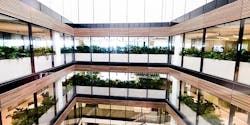How Biophilia and Art Influence Interior Design
Beyond simply accommodating our needs, good design has the capacity to nurture and sustain. In fact, emerging evidence shows that by integrating the beauty of nature and art into interior environments, we as architects and designers even wield the power to heal.
Social ecologist and author of “Biophilic Design” Stephen Kellert has gone so far as to call biophilia our “birthright” as human beings. At a recent talk about his documentary, “Biophilic Design: The Architecture of Life,” he described the experience of walking from a 2,500-car garage into 55 Park Street, a new lab building in New Haven, Conn. adjoining and supporting a cancer treatment center. This transition—one that many people experience—can be jarring and unpleasant. Yet he described his sense of “calm and uplift” as he passed from the dark garage into a soaring atrium dappled with sun, plantings and colorful panels. That’s the power of biophilic design at work.
What is Biophilia?
At the heart of biophilia is a need, deeply encoded within our DNA, for connection to the natural world. That includes sunlight, trees and flowers, and natural materials like wood, sand, leaves and stone. But just as deeply encoded is our intrinsic response to representations of these elements.
Listen: 6 Biophilia Trends You Should Consider for Your Next Interior Project
It turns out that art, like a mirror, reminds us of our humanity and place in nature—especially figurative art depicting human forms or shapes culled from the natural world. With this in mind, it’s a good idea to incorporate figurative art into building designs and interior spaces. Figurative art allows the design team to establish explicit connections to the earth, as well as to the building’s mission and use. Like biophilic design, it can also be a critical element in environments built to nurture, support and protect, including hospitals, senior care facilities, veteran housing, and even schools and libraries.
Research also shows how natural imagery and figurative art contribute to the restoration of directed attention, a central modality of Attention Restoration Theory, which posits that people can concentrate better after being exposed to nature. Just as nature can transfix and fascinate people in a healing way, so too can representations of the natural world. For those confined indoors, artwork of this kind can also provide a “sense of extent,” or a relationship to the vastness of the outdoors. In this way—and like biophilic design—figurative art is a valuable antidote to our largely indoor existence.
Local and Regional Themes
An example of figurative art’s transformative effects can be found in Bridgeport, Conn.’s new Interdistrict Discovery Magnet School (IDMS), an earth sciences-themed school adjacent to a wetlands area and designed in consultation with staff of the nearby Discovery Museum. Drawing on the planned curriculum focusing on earth sciences and math, the walls are built with integrated “fossils”—tiles created by students and embedded into decorative bands of color reminiscent of geological strata. Such elements make IDMS a welcoming place and a “building that teaches, too,” to quote one educator.
Figurative art can also be used to express local and regional themes in ways that help connect entire communities. For example, the recently opened Jonathan E. Reed School in Waterbury, Conn. features integrated art intended to connect children staff and visitors to nature and the local heritage. The imagery of bas relief panels and applied sculptures evoke natural cycles such as the seasons and day and night. Other artworks tie the school to its local history as a clock-making town, and reflect the importance of water in the development of this riverside city.
Likewise, at the Columbus Family Academy in New Haven, the school’s façade features sculptural panels depicting wave and wind patterns, and human forms that represent the “four winds.” Intermingled with shifting brick patterns, the sculptural patterns break down the building’s mass and function as a symbol of the surrounding ethnic diversity.
The Future Challenge of Interior Design
One could put it this way: Figurative art touches more of the self than the work itself. By saying something expressively rather than directly, layers of meaning are conveyed that defy words. Figurative works in interiors and architecture invite the occupant to become involved on any level that he or she is able to, and that is when true healing begins.
This article originally published on November 1, 2013
Barry Svigals, FAIA, is founding partner and Julia McFadden, AIA, is an associate principal for Svigals + Partners in New Haven, Conn., a full-service architecture and planning firm specializing in educational facilities, laboratories and the integration of art and architecture.
More Biophilia in Design: Brand Renovation at Mohawk
